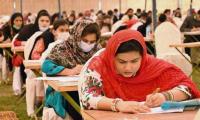An article, titled ‘Back in crisis’, published by The News last month, criticised the incumbent government with regard to the current economic situation, says a rejoinder issued by Finance Division.
It outlined the challenges for the next budget due to the $20 billion trade gap, decreasing foreign exchange reserves, falling home remittances and declining revenues.
The writer stated that the projected five% plus gross domestic product (GDP) growth rate in 2016-17 compared to 4.7% of 2015-16 is fast becoming a delusion. Also, marginal growth in agriculture, which remained negative during the last few years, and large-scale manufacturing (LSM) are also two major factors creating problems.
At the outset, it is important to mention that the author’s assertions are unsubstantiated by credible evidence and his outlook on the economy is overly pessimistic. The misunderstanding of economic data was also observed in the article. The author has portrayed the performance of Pakistan economy based on the past trends in agriculture sector and LSM, which are against the ground realities.
In fact, the recent trends indicate that agriculture is going to take a rebound on the back of relatively better production of major crops over the last year, especially cotton crop, sugarcane and maize. On the other hand, the minor crops are also performing better as compared to last year.
Similarly, the completion of early harvest energy projects under China-Pakistan Economic Corridor (CPEC) is likely to provide some boost to industrial growth. More specifically, the textile industry, which accounts for the largest sub-component of the LSM, is expected to post some recovery in coming months, as exporters cash-flow constraints will ease following the recently announced export package.
The rising economic activity in the country also reflects better performance of the services sector. These trends are also expected to get support from the robust trends in private sector credit, import of machinery and raw materials. Better performance of agriculture and industrial sectors would also have a positive impact on services sector of the economy. Based on these developments, we believe that the GDP growth is likely to remain close to the target set for FY17.
The article also highlights the widened current account deficit. It is important to note that this widening took place due to a sizable increase in import payments and a slight slowdown in exports, besides delayed realisation of coalition support fund (US$550 million in Q3-FY17). However, it should be noted that a large amount of the import bill is being spent on import of machinery and other capital goods which will support the economy in its transition from a low-growth to higher growth phase by addressing the supply-side bottlenecks in energy and infrastructure.
It is also important to understand that most of the import items of the country are inelastic and necessary to increase economic activities and exports from Pakistan. Further, there is a huge increase of 42.3% in import of machinery group, meaning thereby the investment in value added manufacturing sector is increasing in the country. On a positive note, improved law and order, upgraded energy infrastructure, the cash margin imposition, and the export promotion packages, announced by the government, are enabling factors that would ameliorate the current account gap, albeit with a possible lag, in the short to medium term.
In order to contain non-essential imports, the State Bank of Pakistan (SBP) has imposed the requirement of 100% cash margin on import of more than 400 non-essential items. Besides pulling the import bill down, this measure is likely to create financing space for the import of growth-inducing capital goods and raw materials. Also it should be noted that the huge trade deficit is not putting pressure on the inter-bank market, as the exchange rate has shown substantial stability; the rupee depreciated by a nominal 0.1% against the greenback during July-February FY17.
Furthermore, the foreign exchange reserves remained at a high of US$21.8 billion on February 24, 2017. These are sufficient to finance around five months of the country’s import payments. On the export front, there is no denying the fact that Pakistan’s exports have been facing adverse headwinds for the past 2-3 years, mostly due to weak global demand and lower commodity prices. The breakdown of data on exports show that for many product categories, Pakistan exported higher quantities but received lower international prices, meaning that the country was unable to realise adequate FX receipts. For promotion and facilitation of exports, various important steps have been taken, which include: setting up of EXIM Bank, reduction in mark-up rates on export Re-finance Facility and long-term finance facility. Also, the issuance of Strategic Trade Policy Framework (STPF 2015-18) which aims at promoting regional trade besides focusing on product sophistication & diversification, market access, institutional development and trade facilitation. Government is also working to release refunds; this, together with record-low interest rates will address exporters’ liquidity issues. Furthermore, the export package of PKR180 billion has also been announced, which is applicable for nearly 18 months for the period from January 11, 2017 to June 30, 2018. All these efforts will be helpful in improving exports in coming months.
It is also important to mention that due to Global Trade Recession, the World Trade Organisation in its report published on December 9, 2016 indicated that WTO projected a 1.7% increase in world merchandise trade volume in 2016, down from its earlier forecast of 2.8%. The report further envisages that this would mark the slowest pace of trade and output growth since the financial crisis of 2009.
Furthermore, as per data compiled by WTO, quarterly world merchandise exports decreased to US$3,676 billion in first quarter of the year 2016 (latest available data) as compared to the export of US$4,019 billion in same period in 2015, showing a decrease of 8.5%. Hence the data indicates a global declining trend in exports, however, in case of Pakistan, the exports in the current year has shown decline of 3.9% only. The export has decreased to US$13.318 billion in July-Feb, 2016-17 as compared to US$13.859 billion in same period last year (2015-16).
It shows that Pakistani exports have performed better than the world exports. With regard to the decline in remittances, it is important to mention that remittances are one of the main factors in the stability of external account. However, during Jul-Feb FY2017, remittances declined due to inflows dropping from all three major corridors – the Gulf Cooperation Council (GCC), US and UK. Decline in remittances from Saudi Arabia and GCC was on account of slow economic activities in GCC and Saudi Arabia along with fiscal consolidation due to decline in oil price. The decline was also partly due to a seasonal (Eid) factor during Q1 – which had inflated personal transfers in June 2016 and then led to a big drop in the following months.
The pound’s sizable depreciation by 14.0% ($1.42/£ in June 2016 to $1.25/£ in February 2017) against US$ during first eight months of FY2017 is also one of the main reasons due to which remittances from the UK in US dollar declined. The remittances from the US to Pakistan have been declined due to tightening financial sector regulations in the US which are making cross-border fund transfers cost-ineffective for global banks and money transfer operators.
However, the development activities under Saudi Arabia's vision 2030, which provide a roadmap for Kingdom's development and economy for next 15 years, the FIFA World Cup 2022 in Qatar and Expo 2020 in Dubai will create more labour demand, which will have positive impact on remittance inflows going forward. During the recent visit of prime minister to Kuwait, the restrictions on issuing of visas to Pakistani nationals has been lifted by the Kuwaiti government.
Also, the Pakistan Remittance Initiative (PRI) is encouraging banks to increase their outreach efforts and facilitating expat workers to send money to Pakistan through official channels. These developments are likely to keep remittance inflows close to the target. As regard the author’s comments on FX reserves, it is worth noting that the SBP compiles its foreign exchange reserves as per IMF guidelines on “International Reserves and Foreign currency liquidity”.
The assertion on government borrowing of $3.3 billion from the commercial banks and double counting in foreign exchange reserves is factually incorrect and shows lack of understanding of the writer. Furthermore, the government’s commercial borrowing for budget financing is based on fresh FCY funds from abroad and not funded via foreign currency deposits with domestic banks.
Regarding the issue of reduction in collection of withholding tax on banking transaction, the FBR is cognizant of the issue and it has been discussed in the budget making exercise, undertaken at the FBR. The tax under Section 236P was imposed vide Finance Act 2015 and the purpose of the tax is to regulate the economy towards tax compliance. As a result, the number of filers of returns or persons in the Active Taxpayers List is markedly increase reflecting that desired result to document economy and number of people filing tax returns has been largely achieved in the right direction. As a result, the number of non-filers using bailing instruments has decreased. This is not an alarming situation, rather a step in the right direction, as the levy under Section 236P is not a revenue measure but a measure to encourage the taxpayers to file their returns, thereby making the transaction costlier for non-filers.
The News article also incorrectly stated that the incumbent government added $12.2 billion to external debt and liabilities during the last three years as against $14.7 billion, accrued by the previous government in their tenure. The stock of public external debt as at end June 2016 stood at $57.7 billion, up from $48.1 billion as at end June 2013, indicating increase of $9.59 billion during three years of the incumbent government’s tenure instead of $12.2 billion as mentioned in the article.
It may also be noted that part of this increase has come from the IMF debt, which has been taken only for balance of payment support, repayment of pending instalments due to the IMF of loan, taken by previous government in July 2011and not for budgetary financing.
Finally, any unbiased financial expert would endorse that instead of reading out the nominal growth of external debt, it must be seen how its volume has grown relative to the country’s foreign exchange (FX) resources, FX earnings and GDP.
Similarly, the servicing burden must not be viewed in isolation but relative to FX earnings. A pragmatic approach is to measure the “net external indebtedness” of the country, which is the difference between external public debt and official FX reserves. As at end June 2013, the SBP FX reserves were around $6 billion, out of which $2 billion were through short term FX swap with a friendly country, maturing in less than 60 days. Therefore, practically SBP’s true FX reserves were $4 billion as at end June 2013 against which external public debt stood at $48.1 billion, thus net external indebtedness on June 30, 2013 was $44.1 billion ($48.1 billion - $4.0 billion). As at end June 2016, the FX reserves of SBP were $18.1 billion and external public debt stood at $57.7 billion, thus net external indebtedness was $39.6 billion ($57.7 billion-$18.1 billion). Therefore, net external indebtedness of the country improved by $4.5 billion by end June 2016 compared with end June 2013.
The article also baselessly states that country’s external debt is projected to reach over $100 billion by end June 2020 based on estimation of self-proclaimed debt analysts/economists. The said economists had previously made many such false projections in the past such as “economy slipping into deflation” which did not materialise. In fact, the real economic growth has continuously gained momentum in the last three years along with the contained inflation which is an ideal situation for developing countries like Pakistan.
Encouragingly, the GDP growth rate of Pakistan remained higher during the past few years as compared to the global GDP growth rate. Most importantly, thorough analysis of the economy of Pakistan conducted by the IMF in their twelfth and final review projected that the external public debt would be around $62 billion by 2019-20 from its present level of $57.7 billion indicating annual growth of below 2%. The debt sustainability analysis by the IMF show that external debt would remain on a downward trend over the medium term, with the peak in external financing needs under the most stressed scenario staying well below the risk assessment benchmark.
Furthermore, the credit rating agencies in their recent reports acknowledged this fact that Pakistan external debt is on sustainable path. The article has created sensation by wrongly stating that the government has to make $15 billion repayments in 2016-17 and subsequently contradict itself by stating that out of this $15 billion, $7 billion would be against financing the debt servicing requirement. Also, the article incorrectly quoted the finance minister as having said that the government had to pay back $2 billion every year to its foreign creditors. In fact, he said in his recently published article titled “Pakistan's debt: putting the record straight” clarified that external debt servicing obligations for Pakistan are not more than an average of $5 billion per annum until 2021. The said article was also published in The News. The clarity regarding the above matters have already been given in the finance minister’s article and at various forums; however, The News article made a deliberate attempt to mislead the public.
A view of the Islamabad Model Postgraduate College H-8. — Facebook/Islamabad Model Postgraduate College, H-8,...
A high-level Syrian delegation, led by Deputy Minister of Education Mr. Rami Al-Dhulli, met with Pakistan's Minister...
Ali Sahin who is member of Türkiye Parliament and Chairman Türk-Pak Parliamentary Friendship Group. — Anadoulu...
Federal Minister for Housing and Works Riaz Hussain Pirzada seen in this image. — APP/File Islamabad:Mian Riaz...
Representational image of green financing. — APP FileIslamabad: Experts have called the government and state bank of...
The Lahore High Court building. — LHC websiteRawalpindi: Chief Justice Lahore High Court Justice Malik Shahzad Ahmed...







